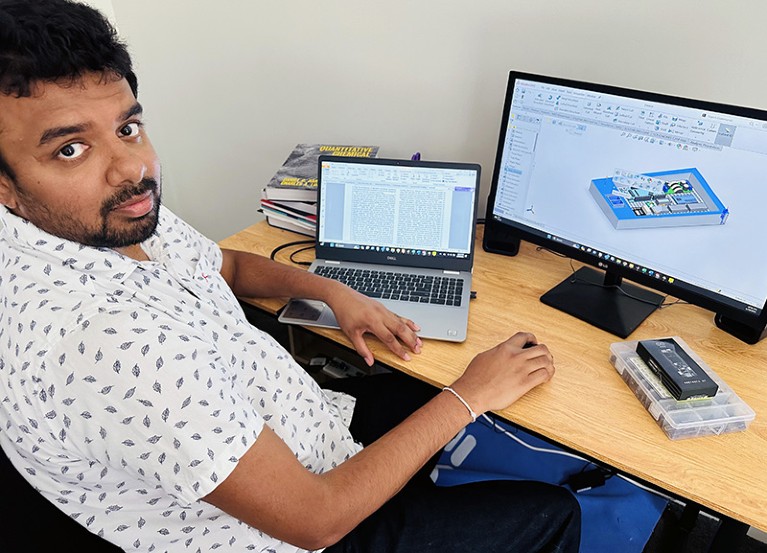
Making a document of all of the papers you have read can help to keep track of what you have learnt.Credit: Getty
When I grew up in Sri Lanka, I often dreamt of how it would feel to invent or find something new. This ambition took me into science, and although the 13 years of education I enjoyed at a school in Colombo provided me with a strong foundation in English, I never thought that I’d spend most of my career writing high-level scientific documents in this language.
I remember the first time I struggled with writing a grant application: I was a postdoc, fresh out of graduate school, at the Southern Methodist University in Dallas, Texas, and felt intimidated by the task. To help me, my adviser shared some of his successful applications, which I studied in-depth to learn the writing style. Although that grant application was not successful, the lessons learnt helped me to improve. Over the next few years, I contributed to six successful grant applications.
After training in the United States as a graduate student and a postdoc, I moved to Australia with my family in 2020. I now work as an analytical chemist at the Australian National University in Canberra, focusing on biosensing and device development. Here are seven tips for writing assignments that have helped me, especially as a non-native English speaker.
Leave blanks
Table of Contents
If you can’t find a suitable word or phrase in the moment of writing, get into the habit of leaving a blank and moving on before returning to it later. This allows you to quickly build a first draft: the hardest stage of writing. The first draft is meant to be messy, and having blanks won’t hurt. Once you have words on the screen, you have something to look at, add to and change — all much easier than filling in a blank screen. It’s easy to edit when you have something to edit.

How sharing your science in an opinion piece can boost your career
This is how I wrote this piece. The first sentence of this subsection initially read as: “If you can’t come up with a suitable word for a specific ____, leave a blank and move on.” I came back later and filled in the blank while refining the sentence.
Start with the most straightforward section
Personally, I find that writing the methods section of a paper first is an effective catalyst for the writing process.
This is the section that I’m most familiar with, and the one in which the words flow immediately, because I’ve already done the experiments and recorded them in my notebook. After that, it’s simply a matter of translating those notes eloquently into text that is both detailed and appealing to the target audience.
Focus on figures
Although a book shouldn’t be judged by its cover, a paper might very well get scrutinized initially on the basis of its figures. Figures provide an important first impression about a paper. In the drafting process, they can also provide a road map on how the paper should be structured. For example, in a paper that I recently worked on that had an overwhelming amount of data, the nine figures we included provided the outline needed to construct the paper. The figures showed us which information was essential for the text, and suggested the order to put it in.
When I construct figures, I instinctively think of the narrative of the paper. Figures are not standalone entities — they aim to coherently connect one part of the story to the next. By looking just at the figures, a reader should be able to visualize the core message of the work.

Sri Lankan chemist Nuwan Bandara improved his English writing skills through his years as a researcher in the United States and Australia.Credit: Buddini Karawdeniya
Because I work on single-molecule sensing, 3D-drawing software can be useful in making the schematics look appealing, as well as adding a ‘wow’ factor to my work. For me, figures provide the best outline for a paper’s results and discussion sections, the parts that I populate after the methods.
Create a knowledge document
When reading background material, compile a document that captures the core message of each relevant paper that you read. I’ve found this to be tremendously helpful, especially when researching a relatively alien subject. You can go through the document in a single pass and read through the central message of each paper (and refresh your memory) without opening them individually.

How Dark Souls and Darth Revan helped me to make sense of my professorship
I can return to this document whenever I want. I used the same approach in a recent paper in which I had to survey the literature on a phenomenon concerning nanopore sensing. In the document, I often recorded findings in the format of ‘A et al. says XYZ,’ and so on.
Of course, reference managers can also achieve a similar result, but they aren’t always as flexible as a self-made document.
Write a crude introduction
An introduction is like a rocket — the mission’s success hinges on a careful design that means it goes straight to its destination, without wobbling or deviating. The introduction also sets the tone for the rest of the paper, and it is crucial that it is well honed to captivate the audience without boring or confusing them. However, writing a well-polished introduction in one sitting might be difficult.
Instead, just as with everything else, I try to compile a rudimentary introduction while leaving blanks in places where my train of thought slows down. This constitutes the skeletal introduction, providing me with a framework on which to expand. Throughout the writing phase, I revisit and refine the introduction — influenced by how the paper develops — until I am truly satisfied with how it flows.

How an AI-powered lion became a teaching tool
Learn from others
Reading papers broadens your comprehension and knowledge of the research field and gives you insights that help you to build a captivating paper. But beyond their scientific content, published papers also serve as useful examples of good writing. During my PhD, I closely followed the writing style of my adviser and others in the field. I started taking notes on how they constructed a paper and the standard of language that they used. Specific phrases and words don’t come naturally to non-native English speakers, such as myself. So, studying papers for their language construction during the early days of postgraduate work pays dividends later.
Study AI-generated texts
Although one should never use material from artificial intelligence (AI) text generators, such as ChatGPT, directly, they can be used to refine and fine-tune sentences and to study sentence structuring. This is similar to the point on learning successful writing patterns. Studying AI-generated texts can help to expand your writing palette. For example, I struggled to find a suitable phrase for something that’s done ‘in one go’ — I noticed that ChatGPT often uses the phrase ‘single pass’ in such cases and I’ve since adopted that in my writing.
Training: Persuasive grant writing
The tips that I’ve shared in this piece were picked up from 11 years of experience as a researcher in the United States and Australia, spanning four universities and five supervisors. In short, starting from a comfort zone such as the methods section, venturing into other sections gradually, making sure to keep a draft moving forward and polishing each section iteratively helped me tremendously in my writing assignments.
